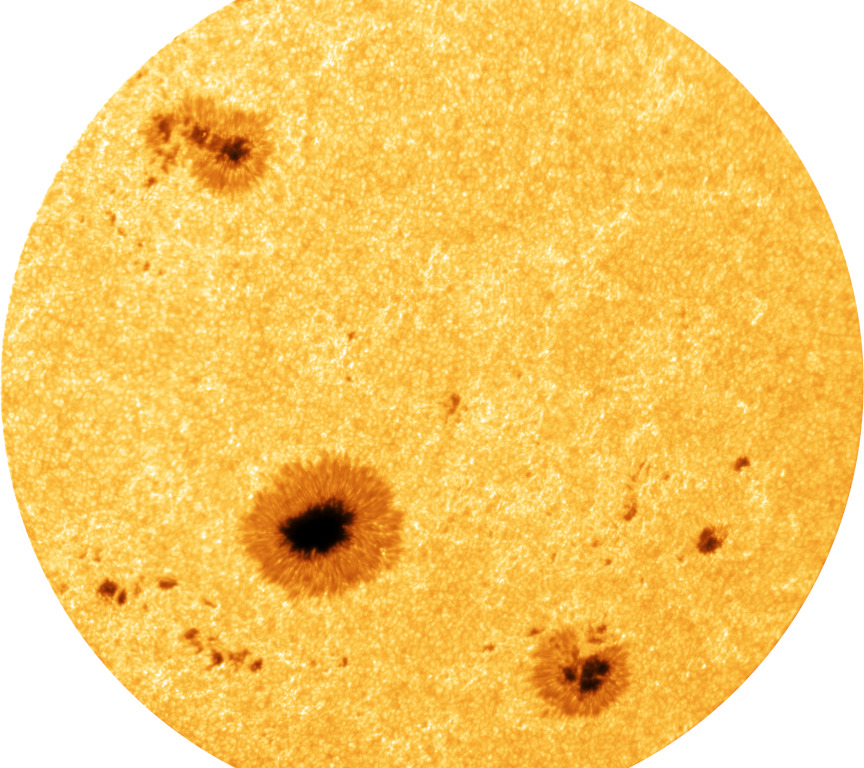A team of solar physicist, among them Markus Roth, director of the Thuringian State Observatory, got a more detailled view of active regions of the Sun. They used a modern camera system and managed to get high-resolution pictures of Sun spots. The pictures were taken at the Vacuum Tower Telescope at the Observatorio del Teide on the island of Tenerife. The Thuringian State Obseratory (Thüringer Landessternwarte, TLS) plans to use another instrument at this observatory as well.
 Images: R. Kamlah et al. 2025
Images: R. Kamlah et al. 2025
Large solar telescopes can observe the smallest details on the surface of the sun, but only in small image sections. As a result, they miss out on the big picture: How is the large-scale environment of these active regions developing? Smaller telescopes in space or in earth-spanning networks observe the entire solar disk around the clock, but they cannot zoom into the complex and rapidly changing structures that are shaped by the sun's magnetic field. The Vacuum Tower Telescope (VTT) can meet both requirements because it has a large field of view and good spatial resolution.
A new, modern camera system from the Leibniz Institute for Astrophysics Potsdam (AIP) makes use of the VTT's large field of view. At the same time, it provides detailed images of the surface of the sun by reconstructing images.
High-resolution images of sunspots
For such a reconstructed image, 100 short time-exposure images with 8,000 × 6,000 pixels are required, which are taken at 25 frames per second. This fast image sequence makes it possible to eliminate the disruptive influence of Earth’s turbulent atmosphere from the solar images.
Viewed in time-lapse, the images provide a better picture of the dynamic processes taking place on the surface of the sun. In short: with the new camera system, details of sunspots become better visible, while at the same time their surroundings remain in view - thanks to the VTT's large field of view.
Getting a better understanding of what’s going on in the Sun’s interior
Research into solar activity is a key focus at the Thuringian State Observatory. In addition to the Tautenburg solar laboratory, researchers at TLS will be using another observation instrument to explore our star: the HELLRIDE instrument, which is also located at the Vacuum Tower Telescope at the Observatorio del Teide on Tenerife in Spain. HELLRIDE stands for Helioseismic Large Region Interferometric Device.
Solar physicists want to use instruments such as HELLRIDE, the new camera system, the Tautenburg solar laboratory and other scientific tools to find answers to the following questions: Does the plasma (the particle mixture of ions and electrons that makes up the Sun) change before a solar flare? How can the magnetic field under the surface of the sun be detected? How do sunspots develop and what happens inside them?
To find answers to such questions, astronomers measure the high-frequency seismic waves of the sun. This is known as helioseismology. They look at longer periods of time to find out how active regions with sunspots change before, during and after a solar flare. The data are obtained using the Tautenburg Solar Laboratory and the HELLRIDE instrument at the Vacuum Tower Telescope on Tenerife, among others. Markus Roth explains why this research is important: “Such studies help us to understand how the strength of solar eruptions varies”.
Strong eruptions and coronal mass ejections occur repeatedly on the sun. They hurl huge amounts of matter into space and create shock waves. The solar wind is suddenly amplified and transports many more particles than usual towards Earth. This material (plasma) can affect technological facilities in space and on Earth as a solar storm. This is known as space weather.
Telescopes such as the Vacuum Tower Telescope and the Tautenburg Solar Laboratory can make important contributions to research into solar activity and therefore also space weather.
Links
Article about the high-resolution images of the sun taken with the new camera system:
R. Kamlah et al. 2025, Wide-field Image Restoration of G-Band and Ca II K Images Containing Large and Complex Active Regions, in: Solar Physics,
doi: https://doi.org/10.1007/s11207-025-02472-6
More information on the HELLRIDE instrument (in German):
www.leibniz-kis.de/de/observatorien/vakuum-turmteleskop/instrumente-am-vtt/hellride

